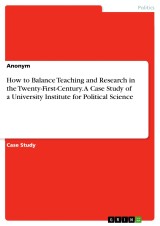Details

How to Balance Teaching and Research in the Twenty-First-Century. A Case Study of a University Institute for Political Science
1. Auflage
|
13,99 € |
|
| Verlag: | Grin Verlag |
| Format: | |
| Veröffentl.: | 22.10.2020 |
| ISBN/EAN: | 9783346280084 |
| Sprache: | englisch |
| Anzahl Seiten: | 15 |
Dieses eBook erhalten Sie ohne Kopierschutz.
Beschreibungen
Case Study from the year 2019 in the subject Organisation and administration - Public administration, grade: 2,3, University of Twente , language: English, abstract: The Public Sector Organization selected for this project was the perfect match for our research, and we managed to obtain the answers we needed efficiently through interviews and surveys. This project main research theme is related to the study of public management, which focuses on the inquiry of how a public organization works and how its environment and the way it is conducted affects directly on its performance and the creation of public value.
It is known that a public organization’s ultimate objective is to deliver services and create public value, as well as to contribute to the design and implementation of public policies. In order to achieve this goal, we can determine the existence of a hierarchy inside organizations, which distinguishes between employees, being who conduct the activities to provide services; and managers, who are the ones that actually "run the organization".
Through our study within the organization, we were able to sustain many of the aspects we learned about in our lectures, such as how internal and external management are a key issue, that is to say that the way managers make their decisions and treat their employees, together with external policies that affect the organization, led directly to their outcomes. After an exhaustive research about the Institute and knowing its political-administrative environment along with other relevant characteristics, we conducted two interviews, one with a middle-manager, specifically a lecturer, who gave us insights about the organization’s funding sources and how external policies affect employees; and the other one with a higher ranked and experienced manager, that revealed how efficient policy-making in conjunction with the role of a good manager will stand out for a good performance. We proceeded by the division of tasks, for example, being three of us the ones interviewing the managers, and the other two remaining doing the transcript. Before the interview, we prepared what questions we were going to ask and how so that we could answer our research thoroughly, and we accompanied this with a survey that the interviewees had to fill out.
It is known that a public organization’s ultimate objective is to deliver services and create public value, as well as to contribute to the design and implementation of public policies. In order to achieve this goal, we can determine the existence of a hierarchy inside organizations, which distinguishes between employees, being who conduct the activities to provide services; and managers, who are the ones that actually "run the organization".
Through our study within the organization, we were able to sustain many of the aspects we learned about in our lectures, such as how internal and external management are a key issue, that is to say that the way managers make their decisions and treat their employees, together with external policies that affect the organization, led directly to their outcomes. After an exhaustive research about the Institute and knowing its political-administrative environment along with other relevant characteristics, we conducted two interviews, one with a middle-manager, specifically a lecturer, who gave us insights about the organization’s funding sources and how external policies affect employees; and the other one with a higher ranked and experienced manager, that revealed how efficient policy-making in conjunction with the role of a good manager will stand out for a good performance. We proceeded by the division of tasks, for example, being three of us the ones interviewing the managers, and the other two remaining doing the transcript. Before the interview, we prepared what questions we were going to ask and how so that we could answer our research thoroughly, and we accompanied this with a survey that the interviewees had to fill out.

















